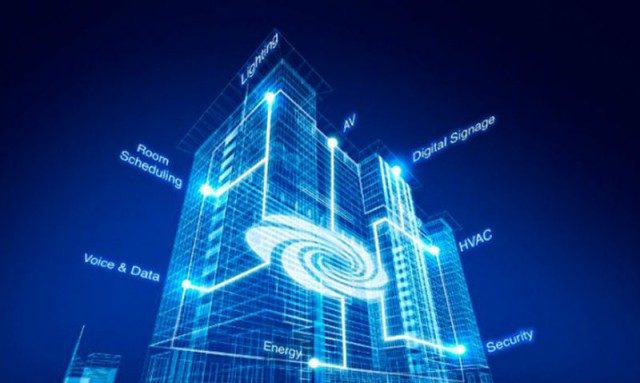How IoT and Smart Buildings Will Reshape a post-Covid-19 World

Smart buildings have made great strides in the last decade in making building systems more efficient, while simultaneously making occupants safer, healthier, and more productive. Darren Bindert of Syscomm looks to the future.
While it is well understood that digital sensors and management systems make it easy to monitor heating, lighting and ventilation systems, data collected from sensors can also be used in much more innovative ways. And as we move out of the current crisis, the use of IoT to make buildings ‘smart’ will enable building operators and owners to better engage with occupants, keeping them informed, safe and productive in a number of interesting new ways.
Smart building technology may still be evolving, but at its core, any adoption needs to improve business performance at the organisational level. The very best smart buildings harvest vast amounts of data from as many different sources as possible - building systems and sensors are capable of providing huge volumes of operational data regarding status, usage levels, maintenance needs and more.
In the post-COVID era, IoT-driven, smart building technology can track the extent to which desks, meeting rooms and other spaces are actually used. Supporting apps can make it easier for colleagues to find and contact each other. Indeed, remote monitoring and real-time occupancy analytics will now be more appropriate than ever with great uncertainty over how offices will be re-occupied in the coming weeks and months.
Smart building technology can help both businesses and employees thrive in several ways.
- Usage Pattern Analysis
Understand how the facility is used, including which areas have higher or lower employee density. Assess time of day and location-based work patterns to improve social distancing policies and formulate return to work plans.
As employees move back into offices post Covid-19, ensuring breakout spaces and office pods are being used effectively and safely is critical. Monitoring space usage allows businesses to understand whether their employees have access to the right amount of safe space, enabling them to make any necessary changes.
- Desk Occupancy
Sensors mounted underneath desks can identify which workspaces are in use to detect real-time occupancy and better manage desk bookings and monitor usage for cleaning. If connected to a reservation system, book, remove or block desks from inventory to improve distancing and overall desk inventory.
For many larger tenants, there is increasingly a strong business case for maximising office occupancy, ensuring that they are not paying for space that is not being used. Accurately understanding desk occupancy rate could save millions of pounds.
Moreover, as part of improving utilisation, IoT offers the ability to better manage the availability of meeting rooms, eliminating the problem of ghost meetings. Ghost meetings compromise productivity as employees can spend valuable time searching for available spaces to conduct a meeting. An enhanced smart building can help enable staff and teams to schedule their days more efficiently.
- Safe Distancing
Reduce occupant density in workspaces and meeting rooms, re-route heavily used pathways, and configure alerts that trigger when a space exceeds safe occupancy.
Connecting IoT sensors and apps to an automated door entry system can, for example, help retail shops with Occupancy Management. By counting the number of people entering and exiting a store, and only providing access when the total number of customers falls below the safe number set by the retail outlet, IoT can automatically help ensure social distancing rules.
- Better Workplace Sanitisation
As a crucial part of ensuring the safety and efficiency of employees, the willingness to return to work will only happen if they are confident in the health and sanitation measures being taken.

Using sensor data to optimise and validate cleaning routines, monitor cleaning crew movements and identify areas that may have been missed and schedule high traffic and high-density areas for regular deep cleaning will nurture a healthy and flexible environment, giving people peace of mind that they are safe and protected at work.
- Environment Control
Monitor CO2 levels, ambient temperature, and relative humidity in specific areas throughout the day. Monitor when door and windows are open or closed, tracking over time to automate building management processes.
Married with live occupancy data to manage space usage, using IoT sensors to implement demand-controlled HVAC and lighting systems that control for air quality and temperature can help keep the environment comfortable for everyone, while ensuring they are provided the healthiest atmosphere possible.
The health crisis is far from over and the full impact of the global lockdown is yet to be seen. In a post-lockdown world, occupancy analytics can maximise the number of people in a space without impacting occupant health, comfort, or productivity.
In the short term, companies going back to work will grapple with how to count, manage, and report on attendance and occupancy. That’s where IoT technologies can help. Today’s IoT Sensors are extremely discreet, and as nervous employees make their way back to the workplace, keeping things as normal as possible for them is crucial. Once the sensors are in place, they cannot be seen, but will be working incredibly hard behind the scenes to make buildings safe and more efficient.
Adding value
Looking to the long term, smart offices make for healthier workplaces. A comfortable physical environment leads to better productivity and higher morale - managing lighting, temperature, air quality and occupancy to best effect results in happier occupants. And this, ultimately increases the profitability of an asset.
If we’ve learnt anything from the COVID-19 pandemic, it’s that business has to be agile. Moving forward, what is going to become more and more important is how building owners harness today’s digital technologies to address tomorrow’s challenges.
Darren Bindert is head of marketing for Syscomm








